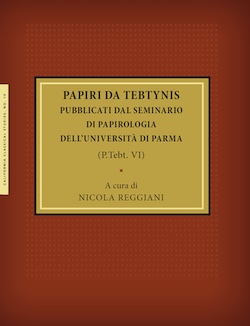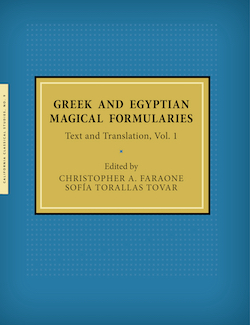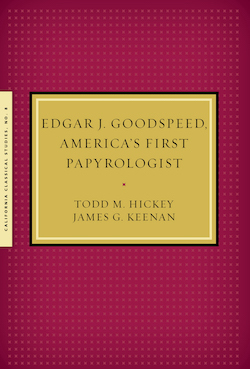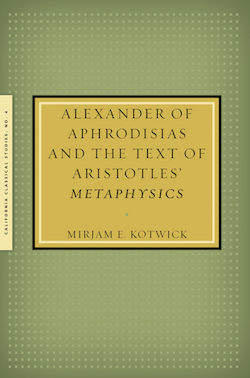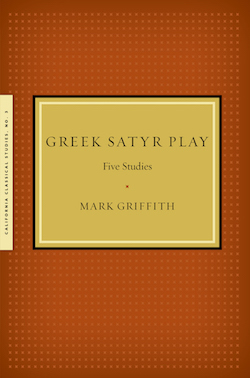California Classical Studies, no. 10
Nicola Regianni (compiler)
Papiri da Tebtynis pubblicati dal Seminario di Papirologia dell’Università di Parma (P.Tebt. VI)
Paperback (special format 8.5×11 inches), pp. xii +276, published May 12, 2025, ISBN 9781939926180, $39.95
Purchase POD paperback from online booksellers (expected available several weeks after publication date) or at any time from our sales page.
Open-access page view at eScholarship page (free PDF download).
Stemming from a seminar held at the University of Parma during the past years, this volume offers 69 editions of papyri belonging to the Center for the Tebtunis Papyri (The Bancroft Library, University of California-Berkeley).
Following the traditional division between literary and documentary texts, the book first presents newly considered or thoroughly revised Homeric papyri, shedding light on the fluidity of textual transmission in antiquity. Significant variants, from simple scribal errors to alternative readings with philological relevance, illustrate the dynamic evolution of Homeric poetry. Additionally, remarkable manuscripts featuring punctuation, prosodic marks, and traces of scholarly annotations offer glimpses into ancient reading practices. An exercise of transcription of a Euripidean verse and a fragment of an unknown philosophical prose text complete the literary section.
The documentary section provides an in-depth look at the administrative, economic, and social landscape of Ptolemaic and Roman Arsinoites. Private and official letters, accounts, contracts, petitions, and tax and land records, illuminate the economic management, bureaucratic machinery, and everyday concerns of individuals and officers, from local scribes to high-ranking officials. A special focus is given to the materiality of the papyri, with a detailed approach to cartonnage fragments featuring figurative elements.By combining philological attention with historical reconstruction, this book offers an indispensable resource for scholars of papyrology, classics, and ancient history, advancing our understanding of both literary traditions and the lived experiences of the past.
California Classical Studies, no. 9
Christopher A. Faraone and Sofía Torallas Tovar, Editors
Greek and Egyptian Magical Formularies: Text and Translation, Vol. 1
Paperback (special format: 8.5×11 inches), pp. xxviii + 531, published April 20, 2022, ISBN 9781939926166, $60.00
Purchase POD paperback from online booksellers (expected available several weeks after publication date) or at any time from our sales page.
Purchase PDF, available only at Lulu.com sales page.
Open-access page view at eScholarship page (free PDF download starting April 20, 2024).
The magical formularies on papyrus are precious witnesses to practices and processes of cultural transmission: i.e. the creation, communication, transformation and preservation of knowledge, both in text and image, across history and between the cultures of Egypt and Greece. More than eighty such handbooks survive, some of them in a fragmentary state. This book, the work of an international team of papyrologists and historians of magic, replaces Papyri graecae magicae edited by K. Preisendanz, which appeared almost a century ago and has been used as one of the most important sources for the study of Greek magic, augmented in the 1990s by the excellent work of R. Daniel and F. Maltomini, the Supplementum Magicum. This project has collected all the known magical formularies and fully studied both their materiality and their texts. The facing English translation with notes replaces The Greek Magical Papyri in Translation, edited by H.D. Betz. This volume, the first of two, presents the earliest of the handbooks, fifty-four in all, spanning the period from second century BCE to third century CE, in a new edition which includes the original texts in the three languages (Greek, Demotic, Coptic) with a full material description and a facing translation with commentary.
California Classical Studies, no. 8
Todd M. Hickey and James G. Keenan,
Edgar J. Goodspeed, America’s First Papyrologist
Paperback, 178 pages, published December 9, 2021, ISBN 9781939926142, $35.54
Purchase POD paperback from online booksellers (expected available several weeks after publication date) or from our sales page.
Purchase PDF, available only at Lulu.com sales page.
Open-access page view at eScholarship page (free PDF download starting in December 2023).
This is a study whose main sources are archival, principally Edgar J. Goodspeed’s “Student Travel Letters” from 1899–1900. These letters home recount Goodspeed’s daily and sometimes hourly activities during nearly two years abroad, in continental Europe, England, Egypt, and the Holy Land, in pursuit of scholarly seasoning. The book’s focus is on his engagement with the newly emergent field of papyrology—the decipherment and study of the ancient Greek manuscripts then being discovered in Egypt. The letters allow for a tracking of this engagement in far greater depth than that allotted in his 1953 autobiography, As I Remember, or in his 90-page unpublished memoir, “Abroad in the Nineties,” filling in some apparently intentional gaps, casting doubt on some of his later self-assessments but putting much additional substance to the claim that he was indeed “America’s First Papyrologist.” The result, part biography, part travelogue, part diary, part academic history, is a description of Goodspeed’s progress, beginning with his enthusiastic commitment to the fledgling field in the late 1890s, ending with his abandonment of it in the early 1900s, possibly a result of his complicated dealings with Oxford papyrologist Bernard P. Grenfell in the fateful summer of 1900. Along the way the book introduces the reader to the world of papyrology in its early days, but it is mainly an account of one budding scholar’s experiences in pursuit of recognition in that subject, a story that has its own complications, narrative arc, and human interest.
California Classical Studies,, no. 7
Olivier Dufault, Early Greek Alchemy, Patronage and Innovation in Late Antiquity
Paperback, 168 pages, published April 13, 2019, ISBN 9781939926128, $30.51
Purchase POD from online booksellers (expected available there within 6–8 weeks) or from our sales page.
PDF version, published April 13, 2019, ISBN 9781939926135, $14.95
Purchase only from our sales page.
Open-access page view at eScholarship page (free PDF download starting in April 2021).
Early Greek alchemy, Patronage and Innovation in Late Antiquity provides an example of the innovative power of ancient scholarly patronage by looking at a key moment in the creation of the Greek alchemical tradition.
New evidence on scholarly patronage under the Roman empire can be garnered by analyzing the descriptions of learned magoi in several texts from the second to the fourth century CE. Since a common use of the term magos connoted flatterer-like figures (kolakes), it is likely that the figures of “learned sorcerers” found in texts such as Lucian’s Philopseudes and the apocryphal Acts of Peter captured the notion that some client scholars exerted undue influence over patrons.
The first known author of alchemical commentaries, Zosimus of Panopolis (c. 300 CE), presented himself neither as a magos nor as an alchemist. In his treatises, he rather appears as a Christian scholar and the client of a rich woman named Theosebeia. In three polemical letters to his patroness, Zosimus attempted to discredit rival specialists of alchemy by describing them as magoi and demon-worshippers and by equating their techniques with Egyptian temple practice. In a subtler attempt to edge out his competitors, Zosimus pointed to their limited education and suggested that true alchemy could only be acquired by a meticulous interpretation of Greek alchemical texts.
Extant evidence thus suggests that alchemical texts were first introduced among other Greek scholarly traditions when Zosimus annexed Egyptian temple rituals into the ambit of paideia thanks to the support and venue provided by his patroness.
California Classical Studies, no. 6
Donald J. Mastronarde, Preliminary Studies on the Scholia to Euripides
Paperback, 278 pages, published November 22, 2017, ISBN 9781939926104, $34.95
Purchase POD from online booksellers, or from our sales page.
EPub (flowing text) version, published December 19, 2017, ISBN 9781939926111, $18.95.
Purchase from online booksellers, or from our sales page
Open-access page view at eScholarship page (free PDF download starting November 22, 2019) .
This work presents five studies that are parerga to the online edition of Euripidean scholia (EuripidesScholia.org), for which the release of a much more complete sample covering Orestes 1–500 is planned for 2018. The first chapter reviews the achievements and shortcomings of previous editions of Euripidean scholia and argues for a more comprehensive treatment of this and similar corpora of scholia and for the importance of glosses. It assesses the few surviving traces in the scholia of views attributed to philologists and commentators working from Hellenistic times to early Byzantium. The second chapter illuminates a genre of annotation termed here “teachers’ scholia,” prominent in many of the younger manuscripts, but also present to a small degree in the oldest witnesses. Evidence for the teaching of Ioannes Tzetzes related to Euripides is gathered more completely than previously, as is that for Maximus Planudes. The third chapter offers an edition and commentary on a miscellany of teachers’ notes on Hecuba first attested in 1287 but clearly copied from an older source, and treats some other unusual notes related to Hecuba carried in Palaeologan sources. The connection of this material with middle Byzantine sources (especially Tzetzes and Eustathius) is assessed. The fourth chapter marshals the evidence for the dating of the Marcianus graecus 471 (M) in the 11th (and not the 12th) century and provides palaeographic and codicological details. The fifth chapter argues that any possibly Planudean connections to Vaticanus graecus 909 (V) are to be found only in the cursive notes added more than a generation after the codex was produced (probably ca. 1250–1280, as proposed by Nigel Wilson). The hands of the two scribes who worked in tandem on V are described, and the distribution of their work documented.
California Classical Studies, no. 5
Joey Williams, The Archaeology of Roman Surveillance in the Central Alentejo, Portugal
Paperback, 168 pages, published February 16, 2017, ISBN 9781939926081, $30.51
Purchase POD from online booksellers, or from our sales page.
EPub (flowing text) version, published February 21, 2017, ISBN 9781939926098, $14.95, available from our sales page, or (within a few weeks) from other retailers.
Open-access page view at eScholarship page (free PDF download starting February 23, 2019) .
During the first century B.C.E. a complex system of surveillance towers was established during Rome’s colonization of the central Alentejo region of Portugal. These towers provided visual control over the landscape, routes through it, and hidden or isolated places as part of the Roman colonization of the region. As part of an archaeological analysis of the changing landscape of Alentejo, Joey Williams offers here a theory of surveillance in Roman colonial encounters drawn from a catalog of watchtowers in the Alentejo, the artifacts and architecture from the tower known as Caladinho, and the geographic information systems analysis of each tower’s vision. Through the consideration of these and other pieces of evidence, Williams places surveillance at the center of the colonial negotiation over territory, resources, and power in the westernmost province of the Roman Empire.
California Classical Studies, no. 4
Mirjam E. Kotwick, Alexander of Aphrodisias and the Text of Aristotle’s Metaphysics
Paperback, 356 pages, published March 11, 2016, ISBN 9781939926067, $40.35
Purchase POD from online booksellers, or from our sales page.
EPub (flowing text), published March 20, 2016, ISBN 9781939926074, $19.95
Purchase at Apple iBooks Store or Barnes & Noble , or from our sales page.
Open-access page view at eScholarship page (free PDF download starting March 16, 2018).
Alexander of Aphrodisias’s commentary (about AD 200) is the earliest extant commentary on Aristotle’s Metaphysics, and it is the most valuable indirect witness to the Metaphysics text and its transmission. Mirjam Kotwick’s study is a systematic investigation into the version of the Metaphysics that Alexander used when writing his commentary, and into the various ways his text, his commentary, and the texts transmitted through our manuscripts relate to one another. Through a careful analysis of lemmata, quotations, and Alexander’s discussion of Aristotle’s argument Kotwick shows how to uncover and partly reconstruct a Metaphysics version from the second century AD. Kotwick then uses this version for improving the text that came down to us by the direct manuscript tradition and for finding solutions to some of the puzzles in this tradition. Through a side-by-side examination of Alexander’s text, his interpretation of Aristotle’s thought, and the directly transmitted versions of the Metaphysics, Kotwick reveals how Alexander’s commentary may have influenced the text of our manuscripts at different stages of the transmission process. This study is the first book-length examination of a commentary as a witness to an ancient philosophical text. This blend of textual criticism and philosophical analysis both expands on existing methodologies in classical scholarship and develops new ones.
California Classical Studies, no. 3
Mark Griffith, Greek Satyr Play: Five Studies
Paperback, 222 pages, published August 23, 2015, ISBN 9781939926043, $30.51
Purchase POD from online booksellers, or from our sales page.
EPub (flowing text), published August 30, 2015, ISBN 9781939926050, $14.95
Purchase at Apple iBooks Store or Barnes & Noble , or from our sales page.
Open-access page view at eScholarship page (free PDF download: because of technical issues related to a platform upgrade as well as permission restrictions, the end of the embargo on this download has had to be postponed to November 2017 from the originally planned date of September 2, 2017).
With a new introduction and some revisions, these essays on Classical Greek satyr plays, originally published in various venues between 2002 and 2010, suggest new critical approaches to this important dramatic genre and identify previously neglected dimensions and dynamics within their original Athenian context. Griffith shows that satyr plays, alongside the ludicrous and irresponsible—but harmless—antics of their chorus, presented their audiences with culturally sophisticated narratives of romance, escapist adventure, and musical-choreographic exuberance, amounting to a “parallel universe” to that of the accompanying tragedies in the City Dionysia festival. The class oppositions between heroic/divine characters and the rest (choruses, messengers, servants, etc.) that are so integral to Athenian tragedy are shown to be present also, in exaggerated form, in satyr drama, with the satyr chorus occupying a role that also inevitably recalled for the Athenian audiences their own (often foreign-born) slaves. Meanwhile the familiar main characters of tragedy (Heracles, Danae and Perseus, Hermes and Apollo, Achilles, Odysseus, etc.) are re-deployed in an engaging milieu of erotic encounters, miraculous discoveries, guaranteed happy endings, marriages, and painless release from suffering for all—both for the well-behaved heroes and also for the low-life, playful satyrs (the “slaves of Dionysus”). In their fusion of adventure and romance, fantasy and naïvete, Aphrodite and Dionysus, Athenian satyr plays thus anticipate in many respects, Griffith suggests, the later developments of Greek pastoral and prose romance.
California Classical Studies, no. 2
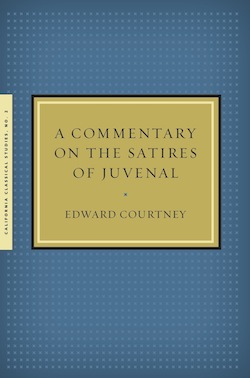
Edward Courtney, A Commentary on the Satires of Juvenal
Paperback, 583 pages, published October 9, 2013, ISBN 9781939926029, $49.95
Purchase POD from online booksellers, or from our sales page.
EPub (flowing text), published October 18, 2013, ISBN 9781939926036, $24.95
Purchase at Apple iBooks Store or Barnes & Noble , or from our sales page.
Open-access page view (also free PDF download) at eScholarship page.
Edward Courtney’s study of the Satires of Juvenal is the only full-scale commentary on the corpus since the nineteenth century and retains its value for students and scholars a generation after its first appearance in 1980. This commentary incorporates the findings of classical study up to that time, including the work of A. E. Housman, new discoveries such as those of papyri, and the expanding horizons of classical research. Courtney elucidates the form of each poem and the progression of thought, and offers many suggestions for the adjustment of traditional punctuation. In addition to basic explanation of the text, the commentary offers a detailed understanding of the literary and historical context, including thorough treatment of social customs, realia, development of the Latin language, and rhetorical features. The Introduction discusses Juvenal’s life, his development as a satirist, his view of society and morals, his style, and his handling of metre.
California Classical Studies, no. 1

Leslie Kurke, The Traffic in Praise: Pindar and the Poetics of Social Economy
Paperback, pages xvi + 250 pages, published August 21, 2013, ISBN 9781939926005, $29.95
Purchase POD from online booksellers, or from our sales page.
EPub (flowing text), published October 7, 2013, ISBN 9781939926012, $19.95
Purchase at Apple iBooks Store or Barnes & Noble , or from our sales page.
Open-access page view (also free PDF download) at eScholarship page.
Pindar’s epinikian odes were poems commissioned to celebrate athletic victories in the first half of the fifth century BCE. Drawing on the insights of interpretive anthropology and cultural history, Leslie Kurke investigates how the socially embedded genre of epinikion responded to a period of tremendous social and cultural change. Kurke examines the odes as public performances which enact the reintegration of the athletic victor into his heterogeneous communities. These communities—the victor’s household, his aristocratic class, and his city—represent competing, sometimes conflicting interests, which the epinikian poet must satisfy to accomplish his project of reintegration. Kurke considers in particular the different modes of exchange in which Pindar’s poetry participated: the symbolic economy of the household, gift exchange between aristocratic houses, and the workings of monetary exchange within the city. Her analysis produces an archaeology of Pindar’s poetry, exposing multiple systems of imagery that play on different shared cultural models to appeal to the various segments of the poet’s audience. The Traffic in Praise aims to provide new insight into Pindar’s poetry as well as into the conceptual world of archaic and classical Greece.

